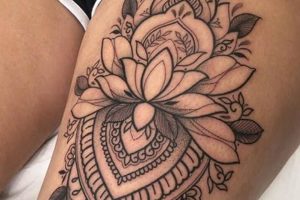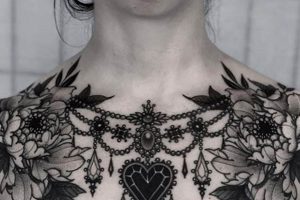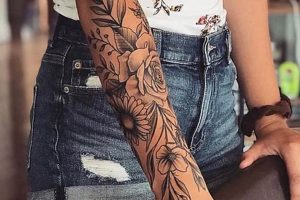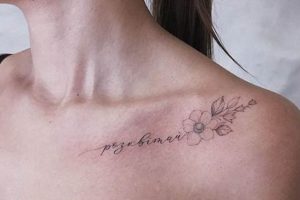Tattoos on the abdominal area offer a unique canvas for artistic expression, allowing individuals to adorn a part of their body often associated with femininity and personal strength. Designs range from delicate floral patterns and intricate mandalas to symbolic representations of personal journeys or powerful statements of self-acceptance. Considerations for placement often involve the navel as a focal point, or the entire abdomen as a space for larger, more elaborate artwork.
This form of body art can be deeply meaningful, serving as a powerful reminder of personal growth, a celebration of womanhood, or an embodiment of resilience. Historically, body markings in this area held cultural significance in various societies, often linked to rites of passage or expressions of fertility and life-giving power. Modern interpretations embrace a broader spectrum of motivations, including aesthetics, personal narratives, and individual style. The ability to conceal or reveal the artwork offers a degree of privacy and control over its visibility.
Key factors influencing design choices include pain tolerance (given the sensitivity of the area), body shape and proportions, and the desired aesthetic. Exploring diverse design styles, considering the long-term implications of permanent body art, and consulting experienced tattoo artists are essential steps in the process of creating a meaningful and aesthetically pleasing abdominal tattoo.
Tips for Abdominal Tattoos
Careful planning is crucial for successful abdominal tattoos. The following tips offer guidance for navigating the process effectively.
Tip 1: Research Experienced Artists: Seek artists specializing in the style desired and possessing a strong portfolio of abdominal tattoos. Their expertise ensures a high-quality, well-executed design.
Tip 2: Consider Pain Management: The abdomen is a sensitive area. Discuss pain management options with the chosen artist and prepare for potential discomfort during the procedure.
Tip 3: Account for Body Changes: Weight fluctuations, pregnancy, and aging can affect abdominal tattoos. Choose designs that adapt well to potential changes in body shape.
Tip 4: Prioritize Aftercare: Proper aftercare is essential for healing and preserving the vibrancy of the tattoo. Follow the artist’s instructions meticulously.
Tip 5: Explore Design Placement: Consider the natural curves and contours of the abdomen when selecting placement. A well-placed design complements the body’s form.
Tip 6: Reflect on Design Meaning: Abdominal tattoos can hold deep personal significance. Choose a design that resonates with individual values and experiences.
Tip 7: Evaluate Long-Term Implications: Tattoos are permanent. Consider the design’s relevance and aesthetic appeal over time.
By following these tips, individuals can ensure a positive and fulfilling experience, resulting in a beautiful and meaningful abdominal tattoo that stands the test of time.
Ultimately, the decision to get an abdominal tattoo is a personal one. Thorough research and careful consideration contribute to a successful and satisfying outcome.
1. Placement
Placement is a critical factor in abdominal tattoo design for women, significantly influencing the aesthetic outcome and practical implications. The abdomen’s natural curves and contours present both opportunities and challenges. A skilled artist uses these contours to enhance the design, creating a harmonious flow that complements the body’s form. Conversely, poorly chosen placement can result in a distorted or unflattering appearance, particularly as the body changes over time. For example, a design spanning the entire abdomen might stretch or distort with weight fluctuations or pregnancy, while a smaller, strategically placed design near the hip bone may be less susceptible to these changes. The central abdomen, around the navel, offers a canvas for symmetrical designs or focal points, while the sides or lower abdomen provide opportunities for more discreet or flowing artwork. Placement also affects visibility, allowing individuals to choose designs easily concealed or prominently displayed.
Several factors influence placement decisions. Pain tolerance varies across the abdomen; certain areas are more sensitive than others. Lifestyle considerations, such as clothing choices and professional requirements, also play a role. A design easily covered by clothing might be preferred by individuals in specific professions. The desired aesthetic also contributes to placement choices; a delicate floral design might be subtly placed near the ribcage, while a bold statement piece might take center stage on the lower abdomen. Consulting with an experienced tattoo artist is essential for navigating these complexities and determining optimal placement.
Ultimately, successful placement enhances the overall aesthetic of the tattoo, complementing the individual’s body and personal style. Careful consideration of placement ensures the design remains visually appealing and personally meaningful for years to come, adapting gracefully to the natural changes bodies undergo.
2. Size and Scale
Size and scale are integral components of stomach tattoo design for women, profoundly impacting the visual harmony and overall effectiveness of the artwork. The abdomen offers a unique canvas with its natural curves and contours; the size and scale of the tattoo should complement these features rather than compete with them. A large-scale design might overwhelm a smaller frame, while a small, intricate piece could get lost on a larger abdomen. Proportion is key. A sprawling design might be better suited to a longer torso, while a more compact design might complement a shorter one. Scale also influences the level of detail possible within the tattoo. Larger designs allow for greater intricacy and complexity, showcasing fine lines, shading, and vibrant color palettes. Smaller designs, conversely, often benefit from simpler, bolder elements to maintain clarity and impact. For instance, a large mandala can incorporate intricate geometric patterns and shading, while a smaller floral design might focus on clean lines and distinct petal shapes. The chosen subject matter also influences size and scale. A detailed portrait requires more space than a minimalist symbol.
Practical considerations also come into play. Larger tattoos require longer sessions and potentially multiple appointments, increasing both the time and financial commitment. Pain tolerance is another factor; longer sessions can be more challenging, especially in a sensitive area like the abdomen. The chosen style also influences size and scale decisions. A delicate watercolor effect might be best suited to a smaller scale, preserving the subtle nuances of color and shading. A bold, traditional style, on the other hand, might lend itself well to a larger scale, allowing the strong lines and vibrant colors to make a statement. The location of the tattoo within the abdominal area also influences size and scale considerations. A design encircling the navel requires careful scaling to maintain symmetry and balance. A piece positioned on the side or lower abdomen offers more flexibility in terms of size and orientation.
Understanding the interplay between size, scale, and the individual’s body shape is paramount to achieving a visually balanced and aesthetically pleasing result. A well-scaled tattoo harmonizes with the body’s natural contours, enhancing rather than detracting from its form. The chosen size should allow the design to shine, showcasing its intended detail and artistry. Careful consideration of these factors ensures a tattoo that remains visually appealing and personally meaningful over time.
3. Style and Design
Style and design are fundamental to the aesthetic success and personal meaning of stomach tattoos for women. The chosen style significantly impacts the tattoo’s visual presentation, reflecting individual preferences and conveying specific messages. A minimalist design featuring clean lines and geometric shapes can project a sense of modern sophistication, while an intricate floral pattern might evoke a more romantic or bohemian aesthetic. Realism, with its detailed depictions of people, animals, or objects, offers another avenue for artistic expression. Script tattoos, featuring meaningful quotes or names, are also popular choices, allowing individuals to carry powerful words or commemorate loved ones close to their hearts. The chosen style should resonate with the individual’s personality and desired aesthetic, creating a cohesive and visually appealing result.
Design considerations involve not only the visual elements but also the conceptual meaning behind the tattoo. Symbolic imagery, such as mandalas, feathers, or religious icons, can hold deep personal significance, representing spiritual beliefs, life journeys, or personal values. Abstract designs, with their focus on form, color, and composition, offer a unique opportunity for self-expression, allowing individuals to communicate emotions or ideas in a non-literal way. The interplay of style and design creates a powerful narrative, transforming the body into a living canvas. For example, a watercolor-style floral tattoo might represent growth and renewal, while a geometric design incorporating sacred geometry could symbolize balance and harmony. The placement of the design also interacts with style and design choices, creating visual flow and balance.
Careful selection of both style and design ensures the stomach tattoo remains a source of personal pride and aesthetic satisfaction. The chosen style should complement the individual’s overall aesthetic and the specific design should hold personal significance. A harmonious blend of style and design, informed by thorough research and consultation with a skilled artist, culminates in a powerful and enduring form of self-expression.
4. Pain Tolerance
Pain tolerance is a crucial factor to consider when contemplating a stomach tattoo. The abdomen is a sensitive area, and the experience can range from mild discomfort to significant pain depending on individual sensitivity, placement, and the complexity of the design. Understanding and preparing for the potential pain involved is essential for a positive tattooing experience.
- Individual Variability:
Pain perception is subjective and varies significantly among individuals. Factors such as genetics, previous tattoo experience, menstrual cycle, and overall health can influence pain tolerance. Some individuals may find the sensation more tolerable than others. Open communication with the tattoo artist about pain levels throughout the process is vital.
- Location on the Abdomen:
Different areas of the abdomen have varying levels of sensitivity. The area directly around the navel, the ribcage, and the sides of the stomach are often considered more sensitive due to thinner skin and proximity to bone and nerve endings. The lower abdomen tends to be slightly less sensitive. Placement choices should consider these variations in sensitivity.
- Design Intricacy and Size:
More complex and larger designs require longer sessions, increasing the overall duration of pain exposure. Intricate details and shading necessitate repeated needle passes, which can contribute to increased discomfort. Smaller, simpler designs generally involve shorter sessions and potentially less pain. Choosing a design appropriate for one’s pain tolerance is key.
- Pain Management Techniques:
Several strategies can help manage pain during the tattooing process. These include deep breathing exercises, over-the-counter pain relievers (consult a physician beforehand), topical numbing creams (discuss with the artist), and maintaining proper hydration and nutrition before the appointment. Distraction techniques, such as listening to music or engaging in conversation with the artist, can also help divert attention from the discomfort.
Careful consideration of pain tolerance, combined with open communication with the tattoo artist, is essential for a positive and successful stomach tattoo experience. Realistic expectations and preparation contribute significantly to managing discomfort and ensuring the process remains as comfortable as possible. Ultimately, understanding individual pain thresholds allows for informed decisions regarding design choices, placement, and session length, empowering individuals to embark on their tattoo journey with confidence.
5. Future Considerations
Permanent body art requires thoughtful consideration of long-term implications. Stomach tattoos for women, specifically, necessitate careful planning due to the body’s natural propensity for change in this area. Factors such as pregnancy, weight fluctuations, and the natural aging process can significantly impact the appearance of abdominal tattoos over time. Addressing these potential changes during the design phase ensures the tattoo remains aesthetically pleasing and personally meaningful for years to come.
- Pregnancy:
Pregnancy significantly alters abdominal skin, causing stretching and potential changes in texture. Tattoos located on the stomach can stretch, distort, or fade during pregnancy. Design choices, such as smaller, less intricate designs placed strategically above or below the navel, can minimize these effects. Consulting with an experienced tattoo artist familiar with these considerations is crucial.
- Weight Fluctuations:
Weight gain or loss can also impact the appearance of stomach tattoos. Significant changes can cause stretching, shrinking, or distortion of the design. Choosing designs that adapt well to changes in body shape, such as geometric patterns or abstract designs, can mitigate these effects. Maintaining a stable weight after getting the tattoo is also beneficial.
- Aging:
Skin loses elasticity with age, potentially affecting the clarity and vibrancy of tattoos. Stomach tattoos are particularly susceptible due to the skin’s tendency to loosen in this area. Selecting high-quality inks, proper aftercare, and sun protection can help preserve the tattoo’s appearance over time. Touch-ups might be necessary down the line to maintain the desired aesthetic.
- Lifestyle Changes:
Future lifestyle changes, such as career choices or personal style preferences, should also be considered. A highly visible stomach tattoo might be less suitable for certain professions. Choosing a design that aligns with long-term personal style preferences ensures the tattoo remains a source of pride and self-expression rather than regret. Discussing these factors with a tattoo artist can provide valuable insights.
Careful consideration of these future considerations ensures the longevity and aesthetic appeal of stomach tattoos for women. Proactive planning, informed decision-making, and collaboration with a skilled artist contribute to a positive and fulfilling experience, resulting in a tattoo that remains personally meaningful and visually appealing throughout life’s various stages.
Frequently Asked Questions
This section addresses common inquiries regarding abdominal tattoos for women, providing factual information and clarifying potential concerns.
Question 1: How much do stomach tattoos typically cost?
Costs vary depending on the size, complexity, artist’s experience, and geographical location. Larger, more intricate designs require more time and skill, thus increasing the price. Researching local artists and requesting quotes is recommended.
Question 2: How long does the healing process usually take?
Healing typically takes several weeks, with complete healing potentially taking up to a few months. Proper aftercare, as instructed by the tattoo artist, is crucial for optimal healing and minimizing the risk of infection.
Question 3: Are stomach tattoos more painful than tattoos on other body parts?
The abdomen is considered a more sensitive area due to thinner skin and proximity to nerve endings. Pain levels vary individually, but generally, stomach tattoos can be more sensitive than tattoos on areas with more muscle or fat.
Question 4: Can I get a stomach tattoo if I plan on having children?
Pregnancy can stretch and alter the appearance of stomach tattoos. While getting a tattoo before pregnancy is possible, understanding the potential impact is crucial. Placement above or below the navel might minimize distortion.
Question 5: How do I choose the right tattoo artist for a stomach tattoo?
Researching artists specializing in the desired style and possessing experience with abdominal tattoos is essential. Reviewing portfolios and seeking recommendations can help ensure a skilled and experienced artist.
Question 6: Can stomach tattoos be removed or covered up?
Laser removal can lighten or remove tattoos, but complete removal is not always guaranteed. Cover-up tattoos are also an option, depending on the existing design. Consulting with a tattoo artist or laser removal specialist is recommended.
Thorough research and careful consideration of the information provided above contribute to informed decision-making and a positive tattooing experience.
For further inquiries or personalized advice, consulting with a qualified tattoo artist is recommended.
Conclusion
Abdominal tattoos offer a powerful canvas for self-expression, allowing individuals to adorn a deeply personal area with meaningful artwork. Careful consideration of placement, size and scale, style and design, pain tolerance, and future implications ensures a successful and enduring result. Navigating these factors requires thorough research, consultation with experienced artists, and a deep understanding of individual preferences and long-term goals. Ultimately, a well-planned abdominal tattoo becomes a beautiful and enduring reflection of personal identity.
The decision to acquire a stomach tattoo represents a significant commitment. Prioritizing informed choices, artistic collaboration, and realistic expectations empowers individuals to embark on this journey with confidence, transforming personal narratives into powerful visual statements. The abdomen, as a canvas, holds the potential for deeply meaningful and aesthetically compelling artwork, reflecting individual journeys and celebrating the power of personal expression.







